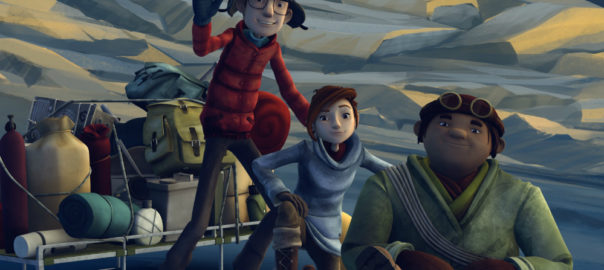FICAM’s focus on African films and its Pan-African attitude towards animation, which I mentioned in the previous blog entry, is evident in the programming of Cameroonian feature-length animation, Minga and the Broken Spoon, by Claye Edou, in the competition. Claye told me that the directors of the festival approached him when the film was still in post-production, and Claye was astounded to find it had been selected. He intended the film for Cameroonian audiences, and never expected it to travel beyond his country’s borders. And yet it did…
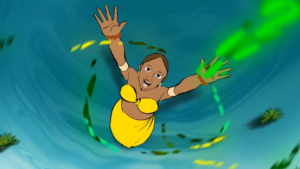
The film is based on a local folk tale and is the very first animated film from Cameroon. It had its premier in November in Cameroon, and Claye told me he was not expecting the film to travel at all. He saw his completion of it, and the success it has had inside Cameroon, as his major achievement. But the film is doing so well in Morocco since this first screening, that Claye has ended up travelling the breadth and length of the country to show it at ten locations in Morocco, to packed screening rooms of very excited and appreciative children. Claye is ecstatic that the film, based on a local story, is so accessible to other cultures as well and now hopes it will travel further still.
The story centres around Minga, a young, beautiful orphan who lives with her cruel stepmother Mami Kaba and her selfish step-sister. Mami Kaba is a malevolent woman in the typical evil stepmother mould (like in Cinderella) who does not hesitate to give all the hard work in the household to Minga. However, Minga does not mind hard work, and she goes about her daily routines dancing and singing. One day, she breaks Mami Kaba’s precious spoon as she washes the dishes in the river. This sparks a fury during which Mami Kaba expels Minga from the family home in order to find the only existing duplicate of this spoon, which belonged to Minga’s mother. It is like trying to find a needle in a haystack. How will Minga deal on her own in the jungle, and how will she overcome the dangers and difficulties presented to her on her way?
The film is a beautifully designed computer animation, on which Claye Edou worked for 3.5 years, with a team of 50 people (including singers, artists and technicians), all the while continuing his full-time job as an accountant. Wizards, magical beasts and enchanting dreams of the past and the future help Minga on her way to overcome adversity and to find the love of her life. The film carries elements of the already-mentioned Cinderella and other princess stories so popular in international fairy tales and is, perhaps precisely because of these universal elements, widely enjoyed.
In a bilingual country like Cameroon, where one half of the film industry has Nollywood-scale ambitions and the other half is dependent on French money, Claye Edou’s first feature length animated film is something of a miracle. This feature length animation is an immense achievement, because – as Florent Coulon shows – the last cinemas in the country were closed in 2009 and filmmaking has since been very minimal. Edou is a young, enterprising and idealistic filmmaker who created Cledley Productions in 2014, specifically to create Minga. It is the result of his passion for art and for telling stories. He is a national award-winning portrait painter, inspired by design and the desire to present oral stories from his own culture. An animation studio based in Douala, Cameroon, Cledley Productions now aims to present to a wider international audience the traditional local oral heritage, and the musical culture of the various regions in Cameroon beyond the Cameroonian borders. With Minga and The Broken SpoonCledley Productions also wants to reposition Cameroonian cinema at the centre of African animation, by becoming a true pioneer of animated film in the sub-region.
For a trailer of the film, see here.
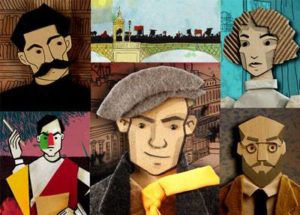
Another feature film we loved in particular was 1917 – La vérité sur octobre// 1917 – The Real October,an animated documentary with live-action interjections,in which Katrin Rothe looks at the lives and times of five artistic-intellectual individuals in the months running up to the October Revolution in 1917’s Russia. She paints a larger picture of the global events, but focuses on the thoughts, diaries, notes and poems by five influential historical figures who have been studied to death by academics and historians. It’s good to see Rothe revive and reanimate them. Unlike the greater historical studies, this film focuses on individual thoughts, details and everyday events. As such, Rothe reveals innermost thoughts, and shows how these characters change their alliances or hold onto their ideals and belief systems. The five main characters are worth mentioning.
Firstly, I loved the characterisation of Zinaida Gippius. A very strong, influential and assured woman, she was the lyricist of symbolism and a famous literary critic who acted as the grande dame of St. Peterburg’s literature and philosophy salon. Her image and recreation in bubble-wrap and cardboard is particularly striking and her face is beautifully captured through layers of paper. In the face of the events surrounding and threatening to drown her, she loses faith in the power of poetry and turns to diaries, becoming in her own words a ‘chronicler’ of events. There is a startling contrast between the throwaway materials that make her image and the value she places on pen and paper to record what she is living through. Secondly, Maxim Gorky was – and is to this day – an internationally known and revered author. He was a dedicated critic of the Tsarist regime. One of the most interesting things in the film is how there was a sliver of doubt and a change of heart in Gorky’s politics during these turbulent times. This was not the case for Vladimir Mayakovsky, the young and revolutionary poet. In the film he’s portrayed as a bit of a Cockney geezer and a chancer, an edgy performance poet of his times. His arrival on screen is often heralded by free-style beat-boxing. He’s particularly proud of the part his own sloganeering poetry plays in the revolution, when the Bolsheviks chant two of his lines:
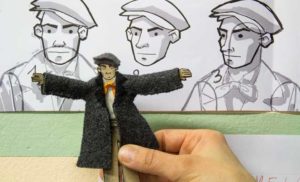
“munch your pineapple, gobble your grouse, your last day’s coming you bourgeois louse!”
The fourth of the main characters is Alexandre Benois, one of the most important art critics of his time, shown to be emotionally very affected by the revolution and the destruction of artistic heritage. When I spoke to Rothe about the film, I pointed out how affected I was by the tears that rolled down Benois’ face, and how real they looked. She joked that water is very visible on paper faces, and that his glasses emphasise his eyes. Lastly, for me the most aesthetically strong character was Kazimir Malevich, a painter, mystic and art theorist who was a pioneer of geometric abstract art. He sympathised with anarchist-individualistic principles. His depiction in cubist clothes and his square head was very effective, specifically in the bright colours (as opposed to the serene white of Zinaida and the dull beiges and browns of Benois and Mayakovsky). These five individuals and their thoughts, reflections and writings paint a much clearer and recognisable situation.

It is also remarkable how Rothe, whose dedication to documentary and animation has made her an artist of some renown, dedicated three of her days at FICAM to workshops with young Moroccan documentary students. This collaboration was established by Hamid Aïdouni, friend of the TMC project and leader of the Tétouan student film festival we wrote about in a previous blog (here). His dedication to the development of confident film students reveals a deep-seated belief in the future of Moroccan filmmaking, and even animation, a form of filmmaking often forgotten about in the country. Rothe’s film has been touring the globe on the film festival circuit, attending both those dedicated to documentary and to animation. In the introduction to the screening of the film, the director of the festival talked about how far FICAM and the freedom of speech elements in Moroccan politics have come: he pointed out that just a few years ago, this sort of political/critical film would not have been allowed to screen in Morocco.
For the trailer, see here.
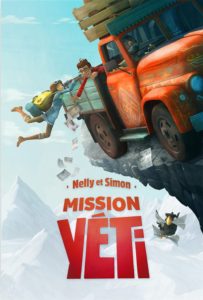
The third feature film we saw was Nelly & Simon: Mission Yetiby Nancy Florence Savard and Pierre Greco. A hilarious caper for children, this film elicited lots of applause and loud laughter, and the filmmaker acknowledged this gratefully, saying that the Moroccan audience is one of her favourites, precisely for these reasons. The story follows impulsive and stubborn Nelly Maloye, a private detective, who joins the fastidious and pragmatic young scientist Simon Picard in Quebec in 1956, on his research trip to the Himalayas, to prove the existence of the Yeti. He believes that he can prove his hypothesis that the Yeti is the missing link in human evolution. Frustrated and nearing the end of his research grant, he is given a three-month reprieve by a wealthy yet caddish investor. Using an explorer’s journal that supposedly contains the location of the mythical creature’s den, Simon and Nelly must learn to combine their methodological and improvisational approaches if they are going to be able to navigate the challenging terrain. With Tensing (perhaps named after the Sherpa from Hillary’s 1953 Everest expedition?), their young guide, and Jasmin, a chatty myna bird, by their side, they face countless adventures and dangers in a beautiful and dangerous terrain. The film took 8 years to complete, is a gem of 3D and showcases the Canadian National Film Board’s investment in animation.
The trailer is available here.
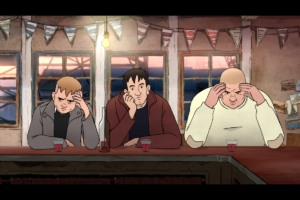
Finally, I want to mention another of our favourite feature-length films, which eventually also won the competition: Un Homme est Mortor A Man is Dead. Adapted for the screen by Olivier Cossu from an graphic novel of the same title by Kris and Etienne Davodeau and looking like Tintin for grown-ups, Un Homme Est Mort takes its title from a poem by surrealist poet Paul Eluard.
Gabriel Péri
Un homme est mort qui n’avait pour défense
Que ses bras ouverts à la vie
Un homme est mort qui n’avait d’autre route
Que celle où l’on hait les fusils
Un homme est mort qui continue la lutte
Contre la mort contre l’oubli
Car tout ce qu’il voulait
Nous le voulions aussi
Nous le voulons aujourd’hui
Que le bonheur soit la lumière
Au fond des yeux au fond du cœur
Et la justice sur la terre
Il y a des mots qui font vivre
Et ce sont des mots innocents
Le mot chaleur le mot confiance
Amour justice et le mot liberté
Le mot enfant et le mot gentillesse
Et certains noms de fleurs et certains noms de fruits
Le mot courage et le mot découvrir
Et le mot frère et le mot camarade
Et certains noms de pays de villages
Et certains noms de femmes et d’amies
Ajoutons-y Péri
Péri est mort pour ce qui nous fait vivre
Tutoyons-le sa poitrine est trouée
Mais grâce à lui nous nous connaissons mieux
Tutoyons-nous son espoir est vivant.
Paul Éluard
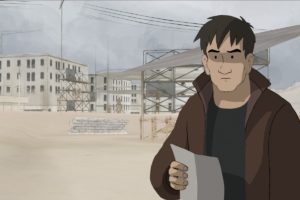
The use of the poem is no mere literary affectation designed to inject the film with a sense of gravitas: this comes naturally when Eluard is given the highest accolade a poet can hope for, to see his poem taken and rendered into the language of the people. Taking place during the workers’ strikes in Brest, France in 1950, this film follows two childhood friends (Petit Zef and Désiré) after their other close friend Edouard has been shot dead in the head by police during a demonstration. A sympathetic filmmaker, René Vautier, is brought in by the Union head to document the grinding poverty of the workers on strike while they push for better pay as they rebuild the war-torn town of Brest. Vautier, it is mentioned in the film, has just returned from making Afrique 50(1956), a strongly anti-colonialist documentary, which made him fall deeply out of favour with the French government. In Brest, Petit Zef and Désiré become his initially reluctant filming assistants and guides. The idea of a film within a film is not new, but the very act of making this documentary film restores a sense of worth and determination to the town and the film reaches its peak towards the end when Petit Zef (who is illiterate) is given the task of reciting Paul Eluard’s poem to accompany a screening of the film to the town. He begins to recite what he knows by heart and then begins to speak in his own words from the heart.
The trailer can be viewed here.
What FICAM shows then, is the inspired, varied internationalist approach to its programme and the direct relevance and inspiration that comes from this selection to its often very young Moroccan audiences. The fact that we saw challenging political films as well as folklore-based fairy tales and humorous detective capers, speaks volumes of the international quality of this festival. Likewise, the attention paid to its filmmakers, the networking opportunities for young filmmakers and students with the more experienced artists, and even the pan-African vibe in some of the best films here, really excited me as an audience member and as a festival researcher. FICAM has great international ambitions and the attentive directors of the festival really work with a vision for the future of the form in mind – both internationally as with regard for students of filmmaking in Morocco itself. Long may it continue…
Next week, in the last blog entry on Meknes, we will reflect on the only Moroccan film in the short film competition: Ayamby Sofia El Khayari.
Stefanie Van de Peer
